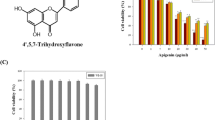Abstract
Objective
The aim of our study was to investigate the effects of (−)-epigallocatechin-3-gallate (EGCG, the major phytochemistry component in green tea) on the expression of connexin43 (Cx43) gene and detect the intercellular communication of the human bladder cancer cell lines BIU-87, and explore its possible mechanisms of prevention and cure for the bladder tumor.
Methods
The methyl thiazolyl tetrazolium and Annexin-V/PI double-labeled flow cytometry methods were used to observe the growth inhibitory rate (IR) and apoptosis rate (AR) of BIU-87 cells treated by EGCG at different concentrations (0, 5, 10 and 20 mg/L), respectively. The reverse transcription-polymerase chain reaction (RT-PCR) and Western Blotting analysis were employed to detect the relative expression levels of the Cx43 mRNA and its protein. The scrape-loading fluorescence dye transfer method was used to assess the gap junction intercellular communication (GJIC) under fluorescence microscope.
Results
EGCG at concentrations (10 and 20 mg/L) both could significantly inhibit the proliferation and induce the apoptosis of BIU-87 cells. The IR and AR were (15.67 ± 1.15)%, (18.33 ± 1.53)% and (42.00 ± 4.34)%, (27.33 ± 3.21)%, respectively. And compared with the control groups of 0 mg/L and 5 mg/L (P<0.05), EGCG could significantly up-regulate the expression of Cx43 mRNA and its protein and enhance the function of BIU-87 cells. The effects had the significant correlation with the dose-dependent of EGCG.
Conclusion
EGCG (10, 20 mg/L) could effectively up-regulate Cx43 expression and enhance the GJIC of BIU-87 cells. The results may indicate the effects of EGCG inducing bladder tumor cells apoptosis and inhibiting its growth which provides the experimental evidence for further demonstrating the mechanism of chemical prevention and cure for the bladder tumor by EGCG.
Similar content being viewed by others
References
Krysko DV, Mussche S, Leybaert L, et al. Gap junctional communication and connexin43 expression in relation to apoptotic cell death and survival of granulosa cells. J Histochem Cytochem, 2004, 52: 1119–1207.
Beltz LA, Bayer DK, Moss AL, et al. Mechanisms of cancer prevention by green and black tea polyphenols. Anticancer Agents Med Chem, 2006, 6: 389–406.
Cao ZG, Qi L, Fang LC, et al. Expression of connexin43 and its correlation with the expression of bcl–2 and bax protein in transitional cell carcinoma of the bladder. Tumor (Chinese), 2007, 27: 398–401.
Rieger-Christ KM, Hanley R, Lodowsky C, et al. The green tea compound, (-)-epigallocatechin-3-gallate downregulates N-cadherin and suppresses migration of bladder carcinoma cells. J Cell Biochem, 2007, 102: 377–378.
Chen JJ, Ye ZQ, Koo MW. Growth inhibition and cell cycle arrest effects of epigallocatechin gallate in the NBT-II bladder tumour cell line. BJU Int, 2004, 93: 1082–1086.
Ogawa T, Hayashi T, Tokunou M, et al. Suberoylanilide hydroxamic acid enhances gap junctional intercellular communication via acetylation of histone containing connexin 43 gene locus. Cancer Res, 2005, 65: 9771–9778.
Takahashi H, Nomata K, Mori K, et al. The preventive effect of green tea on the gap junction intercellular communication in renal epithelial cells treated with a renal carcinogen. Anticancer Res, 2004, 24: 3757–3762.
Ruch RJ, Trosko JE, Madhukar BV. Inhibition of connexin43 gap junctional intercellular communication by TPA requires ERK activation. J Cell Biochem, 2001, 83: 163–169.
Xia ZB, Pu PY, Huang Q, et al. Preliminary study on the mechanism of connexin 43 gene transfection in the control of glioma cell proliferation. Chin J Oncol (Chinese), 2003, 25: 4–8.
Author information
Authors and Affiliations
Corresponding author
Additional information
Supported by a grant from the National Natural Sciences Foundation of China (No. 30801138).
Rights and permissions
About this article
Cite this article
Cao, Z., Tian, C., Jiang, M. et al. Influence of (−)-epigallocatechin-3-gallate on the expression of connexin43 and gap junction intercellular communication of the bladder cancer cell lines BIU-87 in vitro. Chin. -Ger. J. Clin. Oncol. 10, 716–720 (2011). https://doi.org/10.1007/s10330-011-0884-6
Received:
Revised:
Accepted:
Published:
Issue Date:
DOI: https://doi.org/10.1007/s10330-011-0884-6




